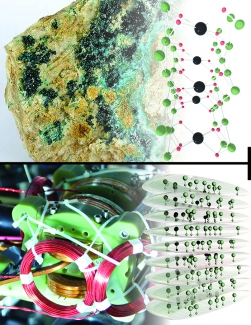Ana Maria Rey’s group is devising new theoretical methods to help experimentalists use ultracold atoms, ions, and molecules to model quantum magnetism in solids. Research associate Kaden Hazzard, former research associate Salvatore Manmana, newly minted Ph.D. Michael Foss-Feig, and Fellow Rey are working on developing new tools to understand these models, which describe both solids and ultracold particles. The theorists are collaborating with three experimental teams at JILA and the National Institute of Standards and Technology (NIST). The experimental collaborations allow the theorists to test and improve their theory with precision measurements of quantum magnetism in action. The action occurs in novel quantum simulators based on neutral strontium atoms (Sr), beryllium ions (Be+), or potassium-rubidium molecules (KRb).
Each simulator uses hundreds of particles whose collective magnetic behavior is far too complex to be solved theoretically even with the most powerful supercomputers. However, experimental observations of quantum behavior in ultracold systems are expected to allow Hazzard and his colleagues to better understand the behavior of their theory. That understanding, in turn, may one day be used to describe real-world materials.
For its part, the new theory’s behavior has already yielded an innovative approach to using a quantum simulator based on ultracold KRb molecules. The new approach suggests starting a quantum simulation by zapping previously prepared quantum states in the simulator with microwave pulses. These pulses drive the quantum states far from equilibrium, resulting in a roiling mass of quantum states.
“Aiming microwaves into a quantum simulator kicks the system from its placid state,” Hazzard said. “If conventional techniques create a gently rippled pond, then this technique generates something more like a cascading waterfall.”
The good news is that a cascading waterfall of quantum states makes it a lot easier for the experimentalists to assess the accuracy of their quantum simulator as well as enhance precision spectroscopy and time measurements. Nonequilibrium simulations can be run at 200 nK instead of temperatures 10–100 times lower.
The bad news is that wildly roiling quantum states are harder to model theoretically. Fortunately, Hazzard and his colleagues were able to combine conceptual insights and mathematical skill with supercomputer calculations to come up with new description of a quantum simulator working far out of equilibrium.
As an added bonus, the new theory will be able to guide future experiments with optical atomic clocks as well as quantum simulators based on neutral Sr atoms, ultracold KRb molecules, or Be+ ions. As a result of its collaboration with the John Bollinger group at NIST, for example, the Rey group has completed an important theoretical investigation of nonequilibrium dynamics in NIST’s trapped-ion quantum simulator. This work provided support to the Bollinger group in its detection of quantum magnetism inside a trapped-ion quantum simulator in 2012.
Thanks to the collaborations between JILA theorists and experimentalists from JILA and NIST, the field of quantum simulation is literally exploding! — Julie Phillips



 The Physics Frontiers Centers (PFC) program supports university-based centers and institutes where the collective efforts of a larger group of individuals can enable transformational advances in the most promising research areas. The program is designed to foster major breakthroughs at the intellectual frontiers of physics by providing needed resources such as combinations of talents, skills, disciplines, and/or specialized infrastructure, not usually available to individual investigators or small groups, in an environment in which the collective efforts of the larger group can be shown to be seminal to promoting significant progress in the science and the education of students. PFCs also include creative, substantive activities aimed at enhancing education, broadening participation of traditionally underrepresented groups, and outreach to the scientific community and general public.
The Physics Frontiers Centers (PFC) program supports university-based centers and institutes where the collective efforts of a larger group of individuals can enable transformational advances in the most promising research areas. The program is designed to foster major breakthroughs at the intellectual frontiers of physics by providing needed resources such as combinations of talents, skills, disciplines, and/or specialized infrastructure, not usually available to individual investigators or small groups, in an environment in which the collective efforts of the larger group can be shown to be seminal to promoting significant progress in the science and the education of students. PFCs also include creative, substantive activities aimed at enhancing education, broadening participation of traditionally underrepresented groups, and outreach to the scientific community and general public.